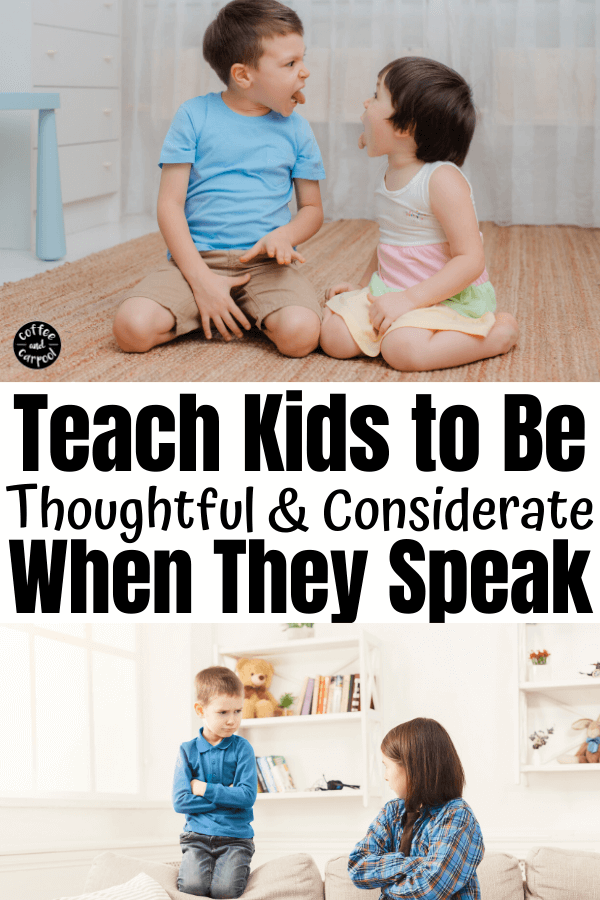Inside: Teach your kids to be more compassionate with these 5 tips every parent and educator needs to know.
When my daughter was little, she came to me crying. She had been out front and fell and stubbed all of her toes. Sweet little thing was in a lot of pain.
I of course comforted her, reassured her, and cleaned up her boo-boos. Then we snuggled on the couch with her most prized possession, her purple blankie, until she was calm again.
A few weeks later, I was moving too fast through my bedroom trying to do all the things and I tagged my knee on the corner of my bed, cutting myself. As I cried out, clutching my knee, my family came running.
My sweet little daughter took one look at me crying and tears welled up in her eyes and she ran from the room.
She came running back in with her purple blankie and thrust it toward me. She wanted to comfort me and she knew her blankie was the best way to offer her love and help. She was willing to give up her comfort item to make me feel better.
The amount of compassion and sweetness in her little body was so incredibly touching. She knew what the pain felt like. But instead of “just” being sad for me, she wanted to do more. She wanted to ease my pain. She wanted to help me to ease my pain.
In that moment, once the mind-numbing pain in my knee subsided, I wanted to harness all of her compassion and teach it to my other children, to all the children.
But it can be hard to teach compassion to kids. Sometimes we need something to make it easier and these 5 strategies will help teachers and educators.
Why we want to raise compassionate kids
We want to raise kind kids so we give them ways to speak and act with kindness in their everyday lives.
We teach them how to be kind to their siblings and how to be kind to their teammates and how to stand up to bullies.
We teach them how to be thoughtful and more considerate of the people around them.
We teach them how to be includers and how to be an ally to their Black classmates and people of color.
But we also teach them how to be more compassionate.
And since we often use the words “sympathy,” “empathy,” and “compassion” interchangeably, to be honest with you, I had to look up the definitions to really understand the different virtues.
Sympathy means you can understand what the person is feeling.
Empathy means you feel what the other person is feeling.
Compassion is noticing their feelings and then wanting to take action to relieve their pain or suffering.
As Compassionit.com describes it, “Compassion kicks empathy and sympathy up a notch. When you are compassionate, you feel the pain of another (i.e., empathy) or you recognize that the person is in pain (i.e., sympathy), and then you do what you can to alleviate the person’s suffering.”
So if we’re going to raise kindhearted, socially aware, thoughtful kids ready to stand up for others who need them, understanding others’ feelings and even feeling what others are feeling isn’t going to be enough.
We have to teach them how to be compassionate so they begin to take action and relieve other people’s pain and suffering.
How to Teach Your Kids to Be More Compassionate
Some kids have a natural tendency to be more compassionate.
These are the kids who share their special blankie or favorite toy with a friend or sibling or Mama who is crying.
Or kids who run to get an ice pack or get an adult when a friend gets hurt.
Or the kid who won the baseball game but ran to hug their best friend who played for the other team.
Compassionate children are not only sad and hurt for their upset or hurt friend, they want to relieve their pain. They want to fix it to make the pain go away.
But some kids, most kids, are pretty me-centered. Since their frontal lobes don’t develop until they’re twenty-five years old, children and teens and young adults are hard-wired to be self-centered.
The good news is, we can teach our children to be more compassionate, even if their brains are still developing.
Parents and educators can show children how to show compassion, even if it doesn’t come naturally to them.
And the more children practice showing compassion to those around them, the more it becomes a habit.
Just like kindness, compassion will become their knee-jerk reaction. They’ll see a friend, classmate, teammate, or sibling in distress and go out of their way to help them.
Strategies to teach our kids how to be compassionate:
1. Build up their Emotional Intelligence
Empathy, sympathy, and compassion start with emotional intelligence.
Emotional Intelligence, according to Psychology Today, “refers to the ability to identify and manage one’s own emotions, as well as the emotions of others.
Emotional intelligence is generally said to include at least three skills: emotional awareness, or the ability to identify and name one’s own emotions; the ability to harness those emotions and apply them to tasks like thinking and problem solving; and the ability to manage emotions.”
So for our young kids, we can simply label their big emotions: “You’re really sad.” “You must feel angry.” “You’re feeling excited.”
We can also show them photos of facial expressions and ask them to label the possible emotions that go with the faces like this Emotional Robot Activity from Lemon Lime Adventures.
Then as they get older, we can ask them how they’re feeling to get them to recognize and then label their own emotions: “How are you feeling?” “Those are big emotions…can you describe them?”
Need more resources for teaching emotional intelligence? This article from Parenting from the Heart goes over the best and worst ways to teach emotional intelligence or this article from Extremely Good Parenting that focuses on how to nurture your kids’ emotional intelligence.
2. Talk about Compassion
We need to intentionally talk to our children about compassion and what it means to show others we really care about them.
But it can be hard to start the conversation. And it’s hard to explain to kids how other people might be feeling.
We want them to “walk in other people’s shoes,” but how do we make that more concrete? Make it something they can really understand.
You can use this Compassion Activity to start the conversation (download it below).

This Walk In Someone Else’s Shoes Freebie comes with:
- 16 realistic mini-stories where compassion is necessary
- a list of feeling words to help children verbalize how someone else would feel and how they would feel in a similar situation.
- a printable to draw or write what they can do to help the person in each story
You can use these to start conversations around the dinner table or during a family meeting or when your child is going through a tricky social situation at school.
If you’re a teacher, you can use these during morning meetings or when you have an extra few minutes before the bell or for your social-emotional learning curriculum.
3. Read Books About Compassion
As we read picture books or chapter books with our kids we can ask them questions about the characters’ feelings.
“How were the three bears feeling when they came home and saw what Goldilocks did to their house?”
“How did the Little Red Hen feel when no one would help her?”
“How do you think Piggie felt? How did Elephant feel?”
We can also read books that specifically teach and talk about compassion.
Here’s a list to get you started:
I am Love: A Book of Compassion
4. Take Care of a Pet
When children take care of an animal who depends on them, not only builds their accountability and responsibility. It also helps build up their compassion.
Not ready to take on a dog or cat? Try a smaller, low-maintenance animal like a fish or African dwarf frog.
Or offer to dog sit or cat sit or fish sit for a neighbor. Kids can also offer to take the class pet over the weekend.
5. Volunteer as a Family
Kindness and compassion are verbs. It’s something we have to do.
One simple way to do that is to help our kids volunteer, give back, and participate in social action, service projects.
Taking action is how we help our kids do more than feel bad for someone else. When we volunteer as a family, we show them it’s in their power to be helpers.
But it can be hard to find kid-friendly ways to get active in our communities. It can also be hard to find time in our schedules for donating and volunteering.
To make it easier, we have a meaningful family-friendly volunteer challenge you can do with your family in under 30 minutes each month, focusing on a different type of volunteering each month.
And we also have this list of 12 of the best kid-friendly volunteer activities to do as a family.
We can make volunteering a normal part of their young lives so they continue to be social activists who continue to do good and be helpers when they’re adults.
Because kids who can recognize there’s a problem, and then feel empowered to solve that problem are my kinds of kids.
They’re the ones who bring their favorite purple blankie whenever someone is hurt.
Get The Walk in Someone Else’s Shoes Conversation Starters here:















Leave a Reply